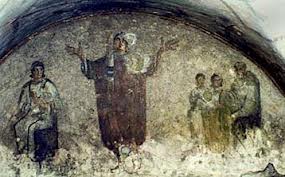
The Tomb of Priscilla
Before the church of Domine Quo Vadis, at the intersection between the Via Appia Antica and the Via Ardeatina an ancient Roman tomb – partially covered by two buildings erected on its structure – of the mound type standing on a quadrangular podium, is to be found.
This is the tomb that Titus Flavius Abascantus, a powerful freedman under Emperor Domitian, had built on his property near the Almone brook on the untimely death of his wife Priscilla. Roman law forbade the dead to be buried within the city walls. Hence, patrician families used to build their graves along consular roads, near the cities, often within their own suburban properties. To those entering the city from then suburbs, the monumental character of patrician tombs was a sign of the prestige enjoyed by the different Roman families.
Poet Statius (Silvae, V. 1) described in detail the funeral of young Priscilla. Her remains, embalmed and shrouded in purple cloth, were laid in a marble sarcophagus, and her likeness reproduced in statues placed within the tomb, portraying goddesses and heroines from Greek and Roman mythology.
Thanks to the cooperation between the Appia Antica Regional Park and the Municipal Superintendency, the tomb which for decades was hidden from the view of those travelling along the Via Appia Antica, has been restored to the central role it deserves. Highly visible from the area of the Catacombs of S. Callisto, the tomb opens the monumental Appia Antica trail.
The tomb in the past and today
Currently, the remains of the monuments are partially hidden by two modern farmhouses. The first, close to the Via Appia, probably dating back to Medieval times, has two floors, and an extension on its southern side dating back to the end of the 19th century. The second located on the opposite side of the tomb’s podium whose ancient entrance it hides, is more recent, and incorporates two or more ancient building (Gregorian Cadastre). The Tomb, thought to have been built during the second half of the 1st century A.D., had a quadrangular ground plan over twenty metres per side, and was covered with travertine Opus Quadratum masonry. Today, part of the concrete core of the original podium is extant.
Above it, to cylindrical drums made of tufa Opus Reticulatum masonry were to be found. In the upper one, 13 niches housed statues portraying Priscilla. In the middle of the drum, above an irregular square base, stands a Medieval tower, commonly known as Torre Petro, some six metre in height, and roughly built of various types of stripped material testifying to the fact that probably as early as the 11th century, the tomb was turned into a fortification. Through the farmhouse’s cellar, hiding the original entrance to the tomb, an ancient corridor covered by a barrel vault, leading to the funerary chamber, can be accessed. The walls of this chamber, which is also covered by a barrel vault, were lined with travertine Opus Quadratum masonry, as testified to by a number of remaining blocks. On three sides, niches hosting sarcophagi are to be found. In fact, as recalled by Statius, Priscilla was embalmed according to Oriental custom, and was not cremated according to the funerary customs of the time. The inner part of the tomb has made the object of several changes. Until the 1960s it was used as a “caciara”, a cheese-ripening cave, and wooden structure, used for this purpose, are still standing, placed against the original walls.
The enhancement project
The Municipal Superintendency has recently started a recovery and enhancement programme in the archaeological area of the Tomb of Priscilla.
The action, designed in collaboration with the Appia Antica Regional Park, is placed within the framework of an ampler cooperation agreement between the Park Body and the Superintendency, and aims at arresting the monument’s degradation. It was decided to adopt remedial measures marked by low invasiveness. Materials were chosen carefully, taking into account compatibility criteria, with a view to obtaining optimum visual effects and, concurrently, best technical results.
After removing the grass covering the walls, weed-killing measure were taken. The second phase of the action was focused on eliminating earth deposits, and a number of modern masonry structures, hiding the tomb, were removed.
After the ancient floor level was recovered, the inner walls were cleaned revealing the original tufa blocks. In order to make the Tomb accessible to visitors, it proved necessary to strengthen the surmounting Medieval tower. This action has made it possible for visitors to fully enjoy the monument. A walkway leads to the central section of the tomb (the inner drum), were the back of the niches originally hosting the statues dedicated to Priscilla is visible.
“…. Ranged in a never-ending line, all the balms that the Spring of Arabia and Cilicia produces, the perfumes of Saba, the harvest of India meant to be burned, the incense of the gods, the essences of Palestine and Israel, the saffron of Corico and myrrh sprouts go by. She (Priscilla) lies on a high funeral bed, built by the Chinese (in China), and she is covered by a pall of Tyrian cloth…”
Stazio, Silvae (V.1)








